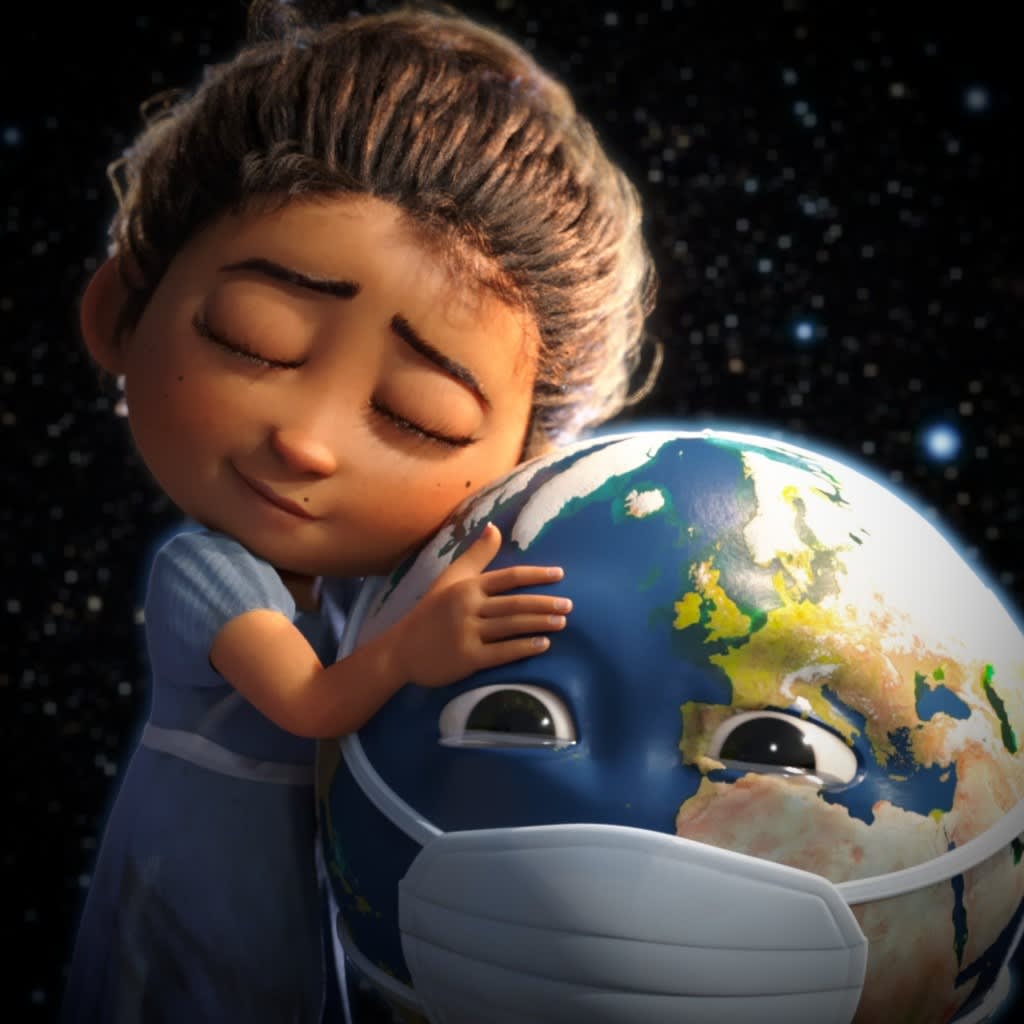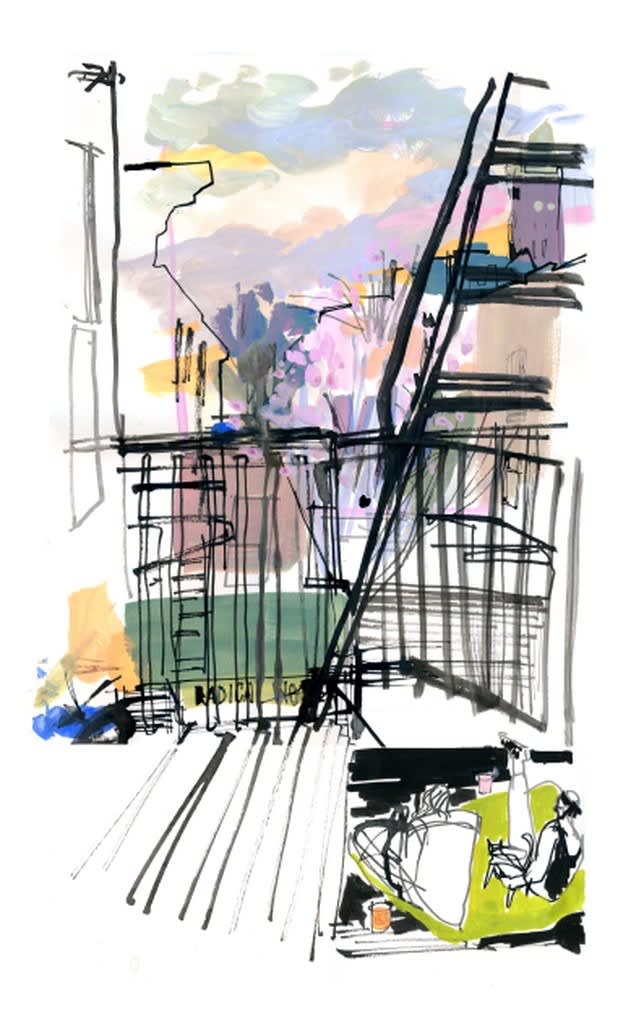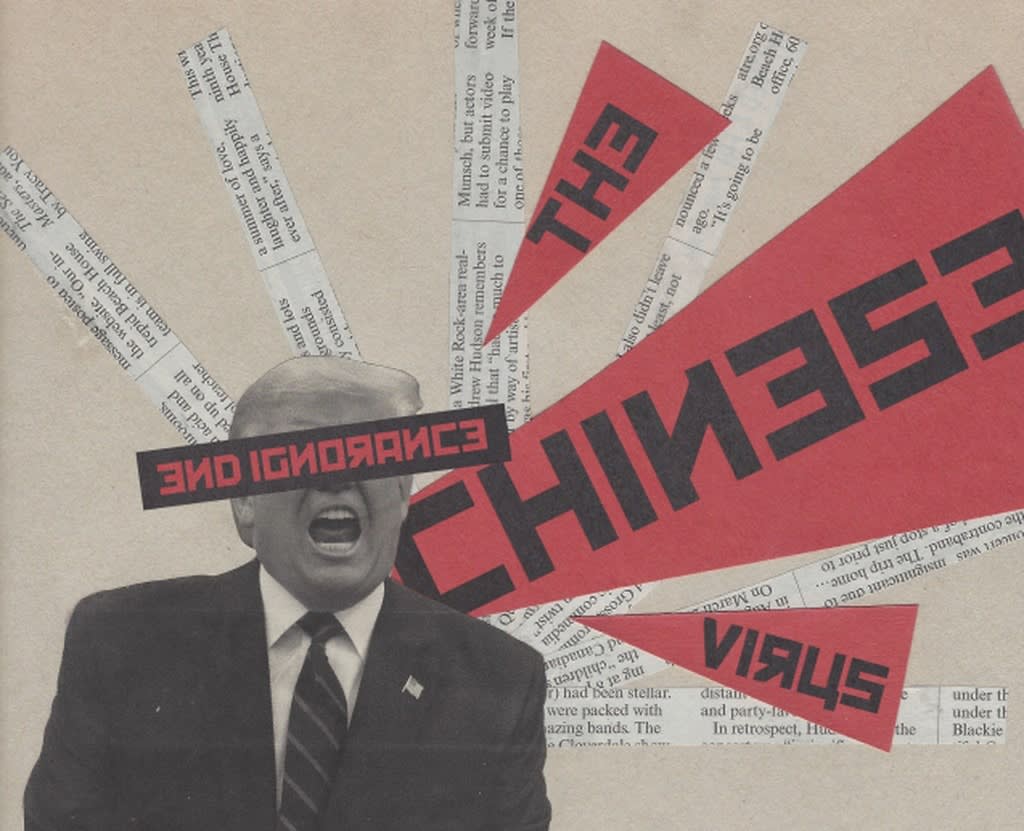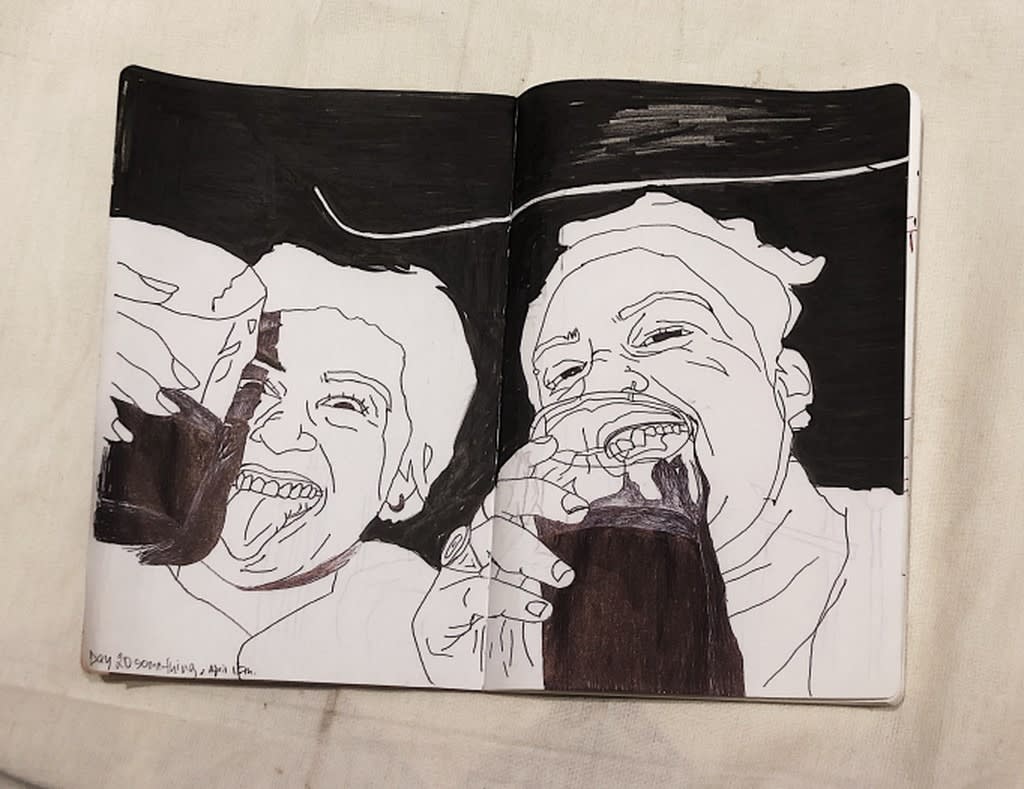
Chrisy Baek, Daniela Dwek and Maya Mendonca (all BFA 2020 Computer Art, Computer Animation and Visual Effects), Tikvah Heals the World, 2020.
A woman sits alone in front of the artwork hanging on her walls, partially obscured by the lush growth of leaves from a houseplant. A couple share a tender kiss, their mouths covered by medical masks. The pastel hues of an early evening summer sky are seen from the barred confines of a fire escape. Each of these scenes, plus more than 300 others, are now a permanent piece of history in the SVA COVID Collection.

Carly Larsson (MFA Illustration as Visual Essay), Fire Escape, 2020.
Started by SVA’s head of archives, Beth Kleber, in the immediate aftermath of the College’s shift to remote operations in mid-March amidst the coronavirus pandemic, the collection is a mix of multidisciplinary works from SVA students, alumni and faculty created over months of self-isolation.
“As soon as academic institutions began shutting down in March, there was a lot of conversation in the archives community about documenting this period in time,” Kleber says. “The fact that our students make art offers a less invasive way to get at the SVA community's experience. I was hoping that art was providing a therapeutic filter for our students, faculty, and staff.” Kleber was proven right when she put out a request for submissions to a new archive collection via a Google Form, with the intention for a completely digital format. The process for submission is simple and accessible, and artists can still contribute, though anything 3D has to be photographed for inclusion. Paintings, sculptures, digital illustrations, videos and photographs from more than 175 contributors (and counting) have been added over the past few months.
These works are painful, uplifting, lived-in, politically charged, frightening, hopeful; they show the dark and the light, the silver linings and the solitude. They show people young and old, abled and disabled, alone and together. They show us at-home still lifes of meals cooked, candles burned, belongings arranged and rearranged, grocery orders, mock magazine covers and advertisements, pieces of propaganda and news media, unmade beds, imagined public service announcements and banal tasks.
Kleber noticed these themes, too. “I think one thing that stood out to me was the mundanity and boredom of being in self-isolation,” she says. “This experience has been traumatic for a lot of people and you can see that in the work, but also there was this permeating sense of isolation and tedium of being stuck inside, without the ability to connect in-person with friends and extended family.”

Emma Joy Sian-E Chin (BFA Design), End Ignorance, 2020.
The titles of the works say it all, telling a story of paranoia and fear, instability, and restlessness: Uncertainty, Letting Go, A Mad World, How to kill time…, Fire Escape, Isolation, Stay Safe, Drive-by Funeral, Grocery Store, Home Sweet Home, Wash Your Hands, I Want to Touch You, Resting, Behind Closed Doors, Neighbors and Alone Together are just a handful.
One standout artist with many works in the collection is Tiffany Alfonseca (BFA 2020 Fine Arts), whose soft black-and-white drawings titled “In Quarantine Series” show peaceful portraits of people isolating at home. Of the work, Alfonseca writes, “Due to the pandemic, I have no studio space for big works so I've created a space for myself in my living room. This inspired me ... because I felt very restricted in a tight space. I found myself wondering how other individuals could relate to this feeling. These drawings are [based on] photos set up by my family, close friends, and Instagram followers. I wanted ... to capture how each individual spends their time during this unique time of quarantine.”

Tiffany Alfonseca (BFA 2020 Fine Arts), drawing from the "In Quarantine" series, 2020.
The aforementioned kiss between a masked couple is titled The Lovers and comes from MFA Art Practice student Shelley Lake. Inspired by a Rene Magritte painting with the same title, The Lovers characters are 3D simulations created in the digital dollhouse on a virtual stage. “Frustrated desire is an understatement at a moment when our world is spiraling out of control,” Lake says of the work. “Mother Nature is having her way with us and passion will prevail.” Lake hopes to continue exploring body language in her thesis work and, like many artists who have submitted, would like to exhibit the work outside of the collection in the future.

Shelley Lake (MFA Art Practice),The Lovers, 2020.
Though many of the works in the archive show the dark side of being in isolation, there are also unexpected bright spots. One is Chenwei Xu’s (MFA 2020 Design) collection of sweet and playful recipe preparation stop-motion videos of dishes like matcha cheesecake and chawanmushi, set to a retro soundtrack. “During quarantine, I was seeking every possible creative way to make our daily life interesting,” Xu says. “My roommate and I tried so hard to improve our cooking skills. Making stop-motion videos started to feel like a mission, we would design, record, and celebrate every dish we made.”
Another is the work from Srishti Dass (BFA Fine Arts) whose series of spare, but vividly human illustrations show joyful scenes of pre-pandemic life, like friends sharing drinks, hugging and riding on the subway. “I made [these] because I was missing my friends and the memories,” Dass says. “I wanted to relive the memories I had before the quarantine. The easiest way for me to do that was to illustrate photos I took of my friends.”
Though these works began as something Dass did to cheer up, they were also a painful reminder of how things had once been. But it wasn’t all for naught: “I still got a lot from the series as it inspired me to do more illustrative and digital works after. I'm an abstract painter so doing semi-realistic illustrations was refreshing.”

Srishti Dass, Untitled, 2020.
As the SVA community has adjusted to this strange new way of being, and as the College looks to a physical reopening in the coming months, the archive has been a crucial way of bringing people together. Artists from all over the world are sharing their experiences with the pandemic, whether deeply personal or just observational. And with no real end in sight, they will likely continue to create, building a capsule for future generations to look back on with bewilderment and awe.
Reflecting on the pandemic and the archive’s ultimate purpose in it, Kleber says, “We're in a rare moment of common experience. I say that with the understanding that there are vast differences racially, geographically, socio-economically, generationally, that determine people's experience with COVID-19. I think there's something valuable in seeing how artists respond to crisis. Hopefully it helps us process our own emotions.”
To view the SVA Archives' COVID Collection, visit archives.sva.edu.

